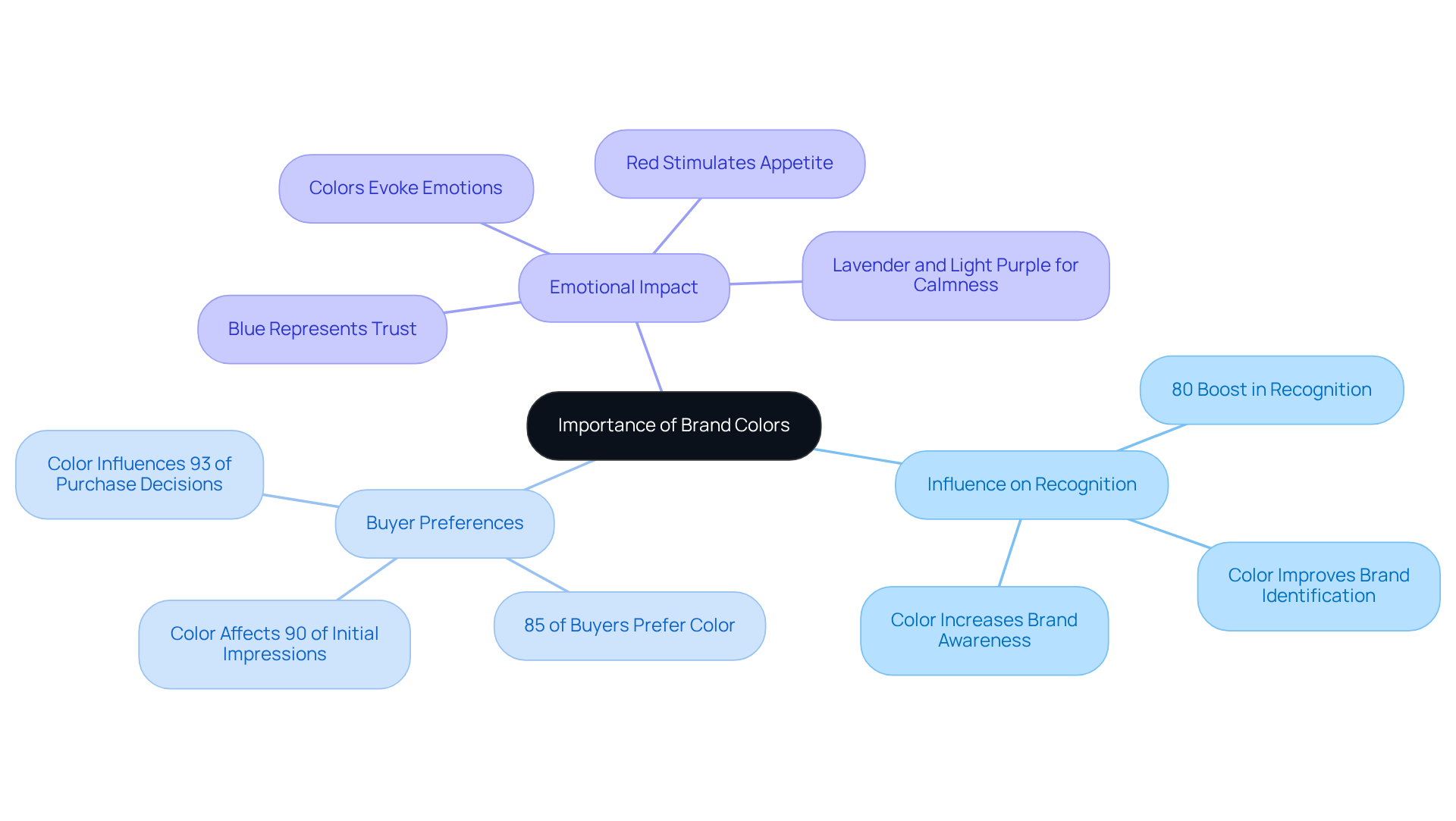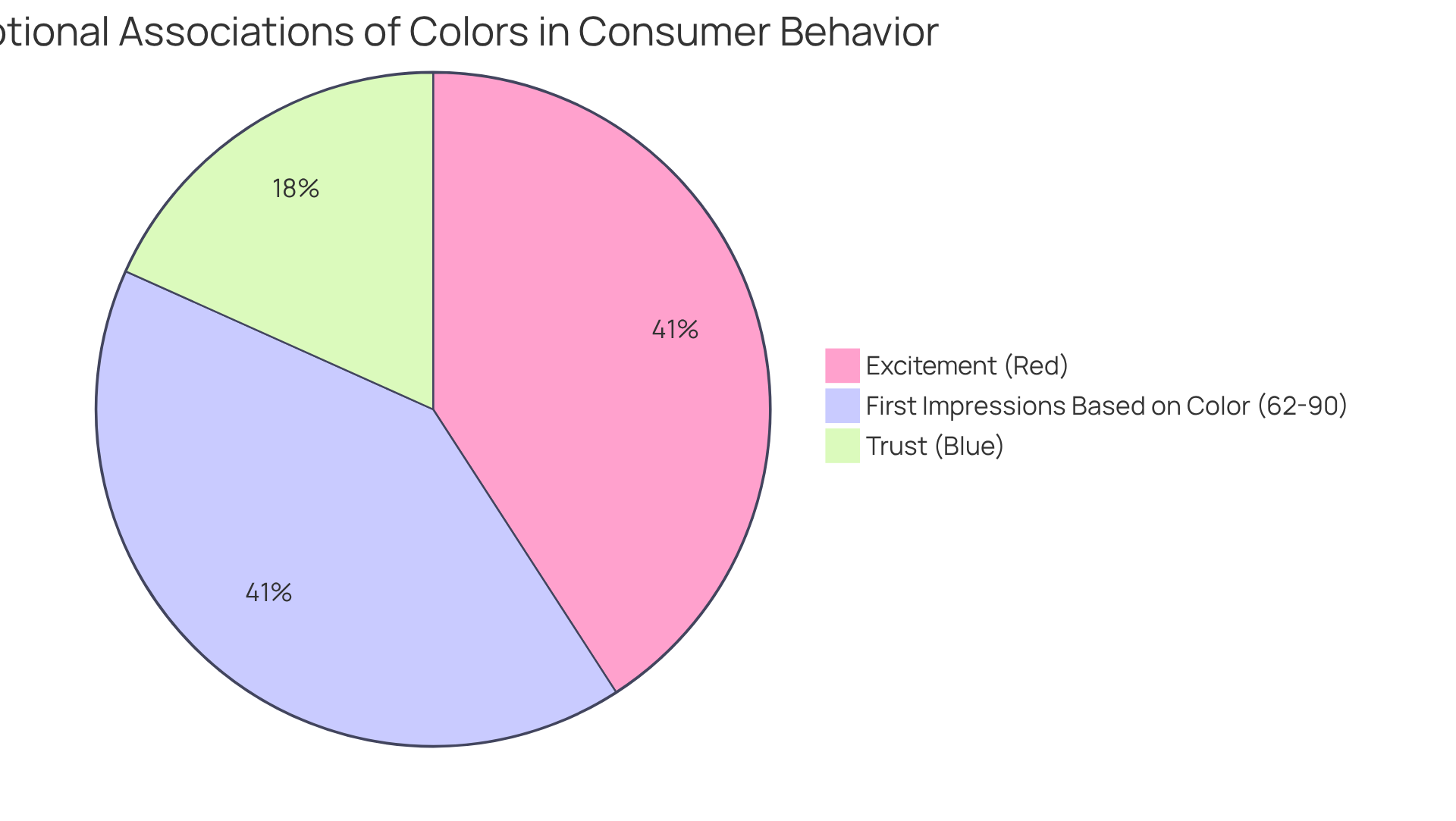Overview
Choosing the right brand colors can feel overwhelming, especially when you consider how much they shape your brand identity and influence consumer behavior. Many founders struggle with this decision, often feeling the weight of its implications on their business’s success. It’s not just about aesthetics; color plays a crucial role in how your audience perceives you. Imagine the impact of a color that resonates deeply with your target market, fostering a sense of trust and connection. Statistics reveal that consistent use of color can enhance product recognition by up to 80%, a powerful reminder of how vital this choice is.
Recognizing the emotional connections that colors can evoke is essential. Think about how certain colors make you feel—warmth, excitement, calmness. These feelings can translate into consumer behavior, influencing purchasing decisions significantly. As you navigate this process, remember that you’re not alone. Many founders have faced similar challenges and have found clarity through thoughtful exploration of their brand's essence.
So, what’s the solution? Start by reflecting on your brand values and the emotions you wish to evoke. Consider your target audience and their preferences. Engaging in this reflective process can illuminate the path toward selecting colors that truly represent your brand. By fostering a deeper understanding of the emotional power of color, you can create a brand identity that not only stands out but also resonates with your audience on a personal level. Together, let’s embark on this journey to find the colors that will bring your brand to life.
Introduction
Brand colors are much more than just aesthetics; they play a crucial role in shaping a company’s identity and influencing how consumers feel and act. Have you ever thought about how colors can affect your perception and decision-making? It’s fascinating to realize that by understanding the profound psychological effects colors have, businesses can create a visual presence that truly resonates. Yet, with so many options available, navigating the complexities of color selection can feel overwhelming.
How can brands ensure they connect with their target audience in a meaningful way? This guide offers a compassionate, step-by-step approach to choosing brand colors that not only reflect your core values but also enhance recognition and foster lasting connections with your consumers. Together, let’s explore how to make this journey a little easier.
Understand the Importance of Brand Colors
Brand colours are not merely colors; they are a crucial component of your visual identity, significantly influencing how customers perceive and remember your label. Have you ever considered how your brand colours affect recognition? Studies reveal that consistent use of specific hues can boost product recognition by as much as 80%. This statistic underscores the critical role colors play in your marketing strategies.
Moreover, a staggering 85% of buyers indicate that color is the leading factor in their preference for one product over another. This highlights just how influential brand colours are in the decision-making process. Colors evoke emotions and create connections that resonate with your organization’s core values, ultimately guiding buyer behavior and choices.
For example, blue, which is favored by 33% of the world’s top companies, symbolizes stability and trust. This makes it a popular choice among financial institutions and tech firms. Similarly, vibrant colors like red and yellow are known to energize and stimulate appetite, which is why many food brands utilize them to attract customers.
Think of Coca-Cola's iconic red and white branding—it sparks a sense of energy and passion, while the white adds a touch of simplicity. Understanding the is essential for selecting shades that resonate with your target audience and authentically reflect your brand's essence, especially when considering your brand colours. By choosing the right hues, you can forge deeper connections with your customers and enhance their experience with your brand.

Explore the Psychological Effects of Colors
Colors hold a powerful sway over how consumers behave, shaping their perceptions and influencing their decisions in profound ways. Many of us may not realize that blue, for instance, is often associated with trust and reliability. In fact, 34% of people link blue to feelings of trust, making it a popular choice for financial institutions like banks and insurance companies.
On the other hand, red tends to evoke excitement and urgency; 76% of individuals associate red with speed, which explains its frequent use in clearance sales and promotional materials. This connection is crucial, as research indicates that between 62% and 90% of first impressions about products are based solely on color.
Understanding these dynamics is . By recognizing how colors resonate with emotions, companies can choose brand colours that not only reflect their identity but also create a deep connection with their audience's feelings. This thoughtful selection can significantly enhance marketing effectiveness.
Moreover, brand colours can enhance brand awareness and recognition by as much as 80%, underscoring the strategic importance of color in marketing. As we navigate these choices, let’s remember the impact our decisions can have on connecting with consumers in meaningful ways.

Follow a Step-by-Step Process to Select Your Brand Colors
Selecting the right colors for your brand can feel overwhelming, but it’s a crucial step in establishing your identity. Let’s navigate this together, ensuring you feel supported throughout the process.
- Define Your Brand Identity: Start by reflecting on your brand’s mission, values, and target audience. Understanding these elements is vital; after all, and influence 85% of consumer buying choices. This foundational knowledge will empower you to make informed decisions.
- Research Competitors: Take a moment to observe the color schemes of your competitors. This exploration can unveil trends and highlight opportunities for you to differentiate your brand, helping you stand out in a competitive landscape.
- Choose a Main Hue: It’s time to select a main color that resonates with your company’s essence. This color will serve as the heart of your brand colours. For example, blue often symbolizes trust and reliability, making it a favorite among tech companies.
- Select Complementary Hues: Next, consider adding 2-3 complementary shades that enhance your primary choice. These colors should work in harmony to create a unified look. Think about how brands like McDonald's use yellow to evoke happiness, while Whole Foods employs green to reflect its commitment to health.
- Test Your Palette: Finally, create mockups featuring your chosen colors and assess their effectiveness across various platforms—your website, social media, and marketing materials. Be open to feedback and adjust as needed. Remember, colors can boost brand awareness and recognition by up to 80%, highlighting just how important this step is. Together, we can ensure your brand shines brightly in the marketplace.

Develop and Implement Your Brand Color Palette
Once you have chosen your brand colours, you may find it challenging to implement your colour palette effectively. This is a common struggle for many startup founders, and it’s essential to address it with care:
- Creating a Brand Style Guide is a vital first step. By documenting your color choices, including hex codes and usage guidelines, you provide a helpful reference for anyone involved in developing promotional materials. This guide ensures that your identity, including your , remains cohesive and recognizable. As Kerry Hounslea wisely notes, "It's clear that thoughtful consideration is essential, as a signature color can enhance recognition by a substantial 80%."
- Next, applying your colors consistently across platforms can be daunting. However, ensuring that your brand colours are uniformly used on your website, social media, and print materials is crucial. Research indicates that consistent branding can boost revenue by 10% to 20%. This not only creates awareness but also fosters trust among your audience. For instance, consider how McDonald's skillfully utilizes its brand colours to establish a strong identity across different cultures.
- Lastly, monitoring and adjusting your color choices after implementation is key. Pay attention to how your audience responds to your selections. Being open to feedback and adapting to your organization's evolving needs is essential. Regularly assessing your palette will help ensure it remains relevant and impactful in conveying your message. Remember, customers need to see your brand at least seven times before making a purchase decision, underscoring the importance of consistent color application for brand recall. Moreover, nurturing and value-driven branding fosters emotional connections, paving the way for long-term customer loyalty. Let’s embrace this journey together, ensuring your brand shines brightly and resonates deeply with your audience.

Conclusion
Choosing the right colors for a brand goes beyond mere aesthetics; it’s a heartfelt journey that shapes identity and influences how consumers feel and act. The importance of brand colors lies in their remarkable ability to evoke emotions, enhance recognition, and ultimately guide purchasing decisions. By understanding the emotional resonance of colors and their profound impact on brand perception, businesses can create a visual identity that truly connects with their audience.
Throughout this article, we've shared key insights on:
- Defining brand identity
- Researching competitors
- Thoughtfully selecting both primary and complementary hues
This step-by-step process offers a clear roadmap for brand owners, highlighting the importance of crafting a cohesive color palette and implementing it consistently across all platforms. Such an approach not only boosts brand awareness but also nurtures trust and loyalty among consumers.
In a world where first impressions hold immense power, the careful selection and application of brand colors can dramatically influence your success. As you navigate the intricate landscape of color psychology and branding, remember that colors are not just tools; they are powerful allies that can forge lasting connections with your customers. By embracing these principles, you can cultivate a more impactful brand presence, encouraging you to take action and refine your color strategies for greater effectiveness in 2025 and beyond.
Frequently Asked Questions
Why are brand colors important?
Brand colors are a crucial component of your visual identity, significantly influencing how customers perceive and remember your brand. Consistent use of specific hues can boost product recognition by as much as 80%.
How do brand colors affect customer preferences?
About 85% of buyers indicate that color is the leading factor in their preference for one product over another, highlighting the influence of brand colors in the decision-making process.
What emotions do different colors evoke?
Colors evoke emotions and create connections that resonate with an organization’s core values, guiding buyer behavior and choices. For instance, blue symbolizes stability and trust, while vibrant colors like red and yellow energize and stimulate appetite.
Can you provide examples of successful brand colors?
An example is Coca-Cola's iconic red and white branding, which sparks a sense of energy and passion, with the white adding simplicity. Blue is favored by 33% of the world’s top companies, often used by financial institutions and tech firms for its associations with stability and trust.
How can choosing the right colors benefit a brand?
By selecting the right hues, brands can forge deeper connections with customers and enhance their overall experience, ensuring that the colors authentically reflect the brand's essence.




